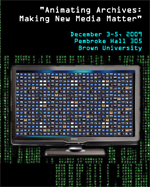About Animating Archives
The paradox of modern media is that it is everywhere and nowhere at once. New media accentuates the “frenzy of the visible” ushered in by film and photography so that we now live in a world saturated with screens, images and objects—from gigantic public screens to cell phones—all demanding that we look at them. At the same time, however, they also work invisibly, turning every day events into fodder for surveillance, adding an invisible layer of code—and a formerly inconceivable amount of data—onto the world. The uptake of these digital telecommunications technologies is thus generating new questions, methods and approaches, the more pressing of which are focused on the archive and archival practice.
How does the new vernacular archive—the flood of YouTube videos, cell phone novels and Facebook entries, as well as “bottom up” archiving sites such as del.icio.us—challenge the traditional function of “public records,” their place and their authority (In Jacques Derrida’s terms, their top-nomological power)? Indeed, if as Derrida has argued, there is no power without access to the archive and what is no longer archived in the same way is no longer lived in the same way, what exactly are we living now and how can we live, write, and think differently? What new global and globalizing memories and fevers are infecting our archives?
These questions, this conference wages, cannot simply be answered using the usual scholarly means, such as print publication. In this sense, we will also be engaging that larger looming question about the “death” of theory. Many have argued that the traditional time of scholarship is too slow to address adequately media events that now happen—and disappear—at the speed of light. Rather than seeing theory as no longer relevant, this conference investigates the various ways theory can “run” in order to address the disconnect between the way that scholarly research in modern culture and media is currently conducted and presented and the world it attempts to describe. This entails inviting not only traditional scholars, but also engaging with scholarly presses and archivists.
This conference coincides with the Cogut Center for the Humanities’s ongoing Digital Humanities Initiative: a university-wide exploration of the vital and fast-growing digital world in relation to the humanities, including the proliferation and accessibility of databases, visualization technologies, and electronic writing and publishing. A self-selecting core group of 35 faculty and staff participants meet regularly to plan such foci as publications programs; uses of the new Humanities Lab in Pembroke Hall, as well as partnerships with external organizations such as the Scholarly Communications Institute (SCI), the Consortium of Humanities Centers and Institutes (CHCI), and CenterNet.
This conference also dovetails with a project funded by the Andrew W. Mellon Foundation to create a Visual Culture Alliance. Conceived initially at the sixth Institute for Scholarly Communication at UVA in the summer of 2007 by Tara McPherson (principal investigator), Nicholas Mirzoeff, Joan Saab, Brian Goldfarb and Wendy Hui Kyong Chun, this project seeks to create a prototype network to advance collaborative and emerging forms of visual culture research and publishing. This new research alliance will focus on the use of digital platforms for collaborative investigation and for sustainable interactive publishing to address pressing research questions specific to the field. The "Animating Archives" conference at Brown will be the first of many events and workshops, which will foster this work.
